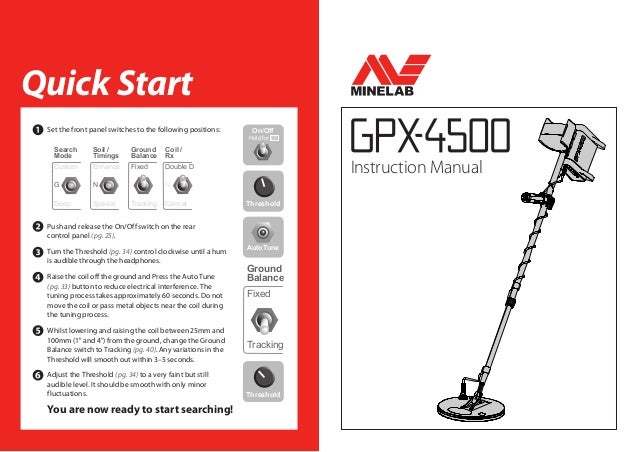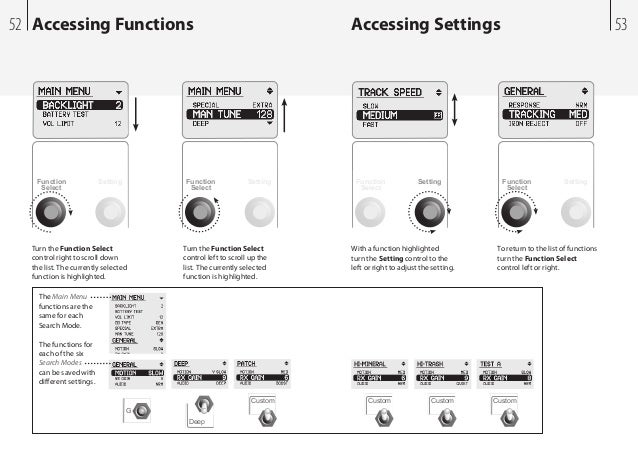Instruction Manual Gpx 4500 Quick Start
The Minelab GPX 5000 Metal Detector is a high-performance gold prospecting detector. GPX 5000 Instruction Manual (Spanish) GPX 5000 Quick Start Guide.
- Read and Download Instruction Manual Gpx 4500 Quick Start Free Ebooks in PDF format THE BABY OWNERS MANUAL ELEMENTARY GUNSMITHING - A MANUAL OF INSTRUCTION FOR.
- Download product manuals for. Ndebele - 5.07 MB GPX-4500 Instruction Manual EN - 3.95 MB GPX-4500 Instruction Manual AR - 4.95 MB GPX 5000 Quick Start Guide.
This page was copied from my GPX5000 settings page after the re-introduction of the GPX4500 to the detecting fraternity. This machine was the predecessor to the GPX5000 and so the settings for it and the way that the detector responds is essentially very similar. There are some small differences in the chart as you will see but the mode of operation and the way of setting up the menu is very close. All the suggestions in the table below are not set into stone and may vary from site to site. They are also dependent on coil size, soil type etc. Use them as a guide to making your own settings for your particular area.
I prefer to run lower gains/motions for a quieter detector and listen for any repeatable signal however small, as opposed to higher settings and a lower SN (signal/noise) ratio. If you believe your settings give you an advantage then by all means, use them. I used to set up GPX 4500 around the settings in the table below with some tweaking as required.
As with my GPX 5000, I have set up Deep mode to look for deeper gold or to run over a patch usually with a larger coil, General mode as a day to day detecting mode, and Patch mode as an EMI blocker for noisy days. I try to run in Deep Mode from the above whenever possible, but if the detector becomes unstable I will switch to General mode, or to Patch mode as required. This means I don't have to access the menu every time I want to make an adjustment, but I still have the option of accessing the menu for minor adjustments though depending on what I am trying to achieve. The manual tune position is where I leave the menu set at as this allows me to make a quick adjustment without even having to look at the menu screen. I usually try to run in the 90 to 100 range of numbers, but if the threshold gets fluttery from EMI a turn of two clicks of the adjustment knob usually settles things down quickly and easily. As with the other GPX Models, controlling interference (EMI) is a balance of the Gain, Motion, Audio and Stabiliser settings.
The gain level you choose is dependent on coil size and EMI levels for a particular day. The Motion filter is used to combat EMI or to match your coil swing speed to the target. A very slow motion speed controls EMI the best, but broadens the response from a target.
The motion speed has a bearing on just how short and sharp the response from the target is. Higher motion speeds 'quicken' the response, so I try and run the highest motion speed that conditions allow, but for our area this usually means slow at best.
The Audio setting for me on a GPX 4500 usually sat at normal, as I find that Deep audio (not the same as Deep Mode) is often too noisy in our area. Deep audio boosts the signal response.
Minelab Gpx 4500 Review
Boost audio is excellent for small coils and the 11' mono coil coupled with Boost audio and Fine Gold setting is a deadly combination on the little bits. Quiet audio is excellent for days that the spikes and EMI are an issue. The gain and stabiliser settings can be elevate to quite high levels when this audio setting is utilised.
I generally run the Stabiliser setting at between 8 and 10. Low levels may cause some targets to be missed entirely if the coil isn't able to be centred over the target. The Stabiliser controls the point at which small variations in the threshold are able to be heard, therefore a low setting will lose those fainter signals.
The target volume control in the lower menu (as opposed to volume limit towards the top which clips extremely loud sounds) is a personal thing, but 8 to 10 for headphones and 10 to 12 for speakers are general settings. Personal preference and hearing ability will affect these results. On windy days you might run this up to 15. All the above was for the lower section of the menu. The upper section consisting of Volume limit, backlight, and down to Manual tune with the exception of the “Special” timings is rarely changed, and the factory pre-sets are fine.
If these settings have been changed then simply restore the factory presets, and then adjust the lower portion as above. The switches on the front panel are constantly used. The mode switch is easiest to think of as being 3 different detectors.

Minelab Gpx 4500 Metal Detector
The settings in the table are for each mode as applicable, being Deep, General and Custom (factory called Patch in the menu). These settings can be altered to make the detector do different tasks or look for different sized targets.
The soil switch sets the detector timing. Normal is the same as all previous models and is best for quieter ground types. The “Special” setting is determined by what selection is made in the menu. There are several choices, of which “Sensitive Smooth” is the factory pre-set. Enhance is the other selection. This timing eliminates most all ground noise and hot rocks except for the extreme ones.

The targets are diminished in volume because as the timing removes the ground noise, it also removes some of the target response. ANY signal that is consistent in both directions needs to be investigated as a possible metal target. If we run in Enhance we usually use a larger mono coil and Fixed ground balance.
The Coil RX switch has several functions as the manual states and more information is found in there. I find that mono coils run slightly more quietly in mono mode than DD. The Tracking switch controls whether we are manually ground balancing in Fixed, or the detector is doing it for us in Tracking.
Most Viewed Pages
- Kubota L4600 Shop Manual
- Owners Manual For Yamaha 2015 Kodiak 450
- Manual Program Fanuc 6m Control
- Management Accounting Horngren Solutions Manual
- Wolf Service Manuals
- Sierra Bullets Reloading Data Manual 218 Bee
- Ford Sony Dab Manual
- Mazda 6 Garage Manual
- Solution Manual Elementary Statistics John Freund
- 49cc Engine Rebuild Manual
- Toyota Sequoia Manual
- Neural Networks Guide
- Cat 432e Manual
- Manual Perennial Irrigation Canal And Canal Structures
- 2018 Yamaha Breeze 125 Manual
- Aqua Hot Shop Manuals 2010
- 2018 Fxdc Super Glide Custom Service Manual
- 04 Honda Crf 450 Manual Svenska
- 2003 Vw Gli Owners Manual
- Truth In Comedy The Manual Of Improvisation